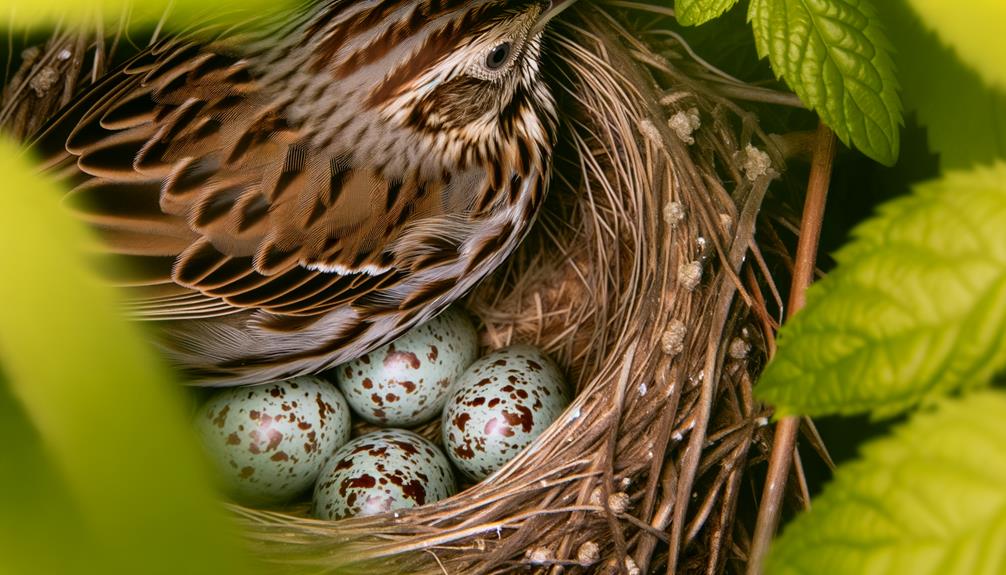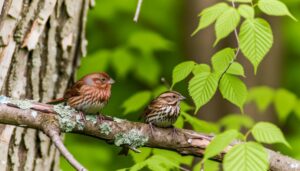How Many Eggs Do Song Sparrows Lay in the Nest?
Song sparrows typically lay between 3 to 5 eggs per clutch, with the precise number influenced by environmental conditions and resource availability. Their eggs are usually pale blue to soft brown, speckled with reddish-brown spots.
Clutch size can vary due to factors like food availability, predation risk, and parental age. The incubation period lasts about 12 to 14 days, with females primarily responsible for maintaining egg temperature.
Understanding these elements provides a deeper insight into the reproductive strategies and survival mechanisms of song sparrows.

Key Takeaways
- Song sparrows typically lay 3 to 5 eggs per clutch.
- Clutch size can vary based on environmental conditions.
- Ideal conditions may lead to clutch sizes of 5 eggs.
- Eggs range in color from pale blue to soft brown with reddish-brown spots.
- Factors such as food availability and predation risk influence clutch size.
Breeding Season Overview
During the breeding season, which typically spans from early spring to late summer, song sparrows exhibit a high level of reproductive activity and territorial behavior.
Males aggressively defend their territories through vocalizations and physical displays to deter rivals and attract females.
Female song sparrows select mates based on the quality of their territories and the males' vocal performances.
Once paired, both sexes participate in courtship rituals that reinforce the bond and signal reproductive readiness.
Hormonal changes in both males and females drive these behaviors, ensuring the synchronization of mating efforts.
This period is critical for the species' reproductive success, as it directly impacts nest initiation, egg production, and ultimately, the survival of their offspring.
Nesting Habits
Where do song sparrows choose to build their nests, and what materials do they use to construct them?
Song sparrows typically build their nests in low shrubs or tall grasses, usually close to the ground. They prefer locations that offer ample cover to protect against predators.
The construction materials vary but often include:
- Grass blades for the outer structure
- Twigs and small sticks to provide a sturdy framework
- Leaves for added insulation
- Animal hair to create a soft lining
- Feathers for extra warmth and comfort
These materials ensure the nest is well-camouflaged and secure.
The female sparrow is primarily responsible for building the nest, showcasing the species' resourcefulness and adaptability in different environments. This careful selection and construction process play an important role in the breeding success of song sparrows.
Typical Clutch Size
After constructing a secure nest, the female song sparrow typically lays a clutch of three to five eggs. This clutch size can vary based on environmental conditions and food availability. Researchers have observed that in ideal conditions, the clutch size tends to be on the higher end, often reaching five eggs.
Conversely, in less favorable conditions, the female might lay only three eggs. This variability ensures the survival of the species, allowing adaptation to fluctuating resources. Additionally, the female's age and health play important roles in determining the number of eggs she'll lay.
Younger females might produce smaller clutches, while experienced breeders often lay more eggs. Understanding these factors offers insight into the reproductive strategies of song sparrows.
Egg Characteristics
Song sparrow eggs exhibit distinct color patterns, typically ranging from pale greenish-blue to soft brown, often speckled with reddish-brown spots. These eggs also show variations in shell texture, with some being smooth while others have a slightly rough surface.
Understanding these characteristics is essential for accurate identification and study of song sparrow reproductive behavior.
Egg Color Patterns
Egg color patterns of song sparrows exhibit a range of hues from pale blue to greenish-white, often speckled with brown or reddish spots. These variations provide camouflage and help protect the eggs from predators. The specific patterns and colors can vary widely among individual sparrows and even within a single clutch of eggs.
Key characteristics include:
- Base Color: Typically pale blue or greenish-white.
- Speckling: Irregular brown or reddish spots.
- Pattern Distribution: Speckles are often denser at the broader end of the egg.
- Size of Spots: Ranges from fine dots to larger blotches.
- Variability: High within and between clutches.
This diversity in egg coloration is a result of evolutionary adaptations, enhancing the chances of survival by blending with the nest environment.
Shell Texture Variations
Noticeably, the shell texture of song sparrow eggs can vary greatly, ranging from smooth to slightly grainy surfaces. This variation in texture is believed to result from differences in the calcium carbonate deposition during eggshell formation.
The smoothness or graininess of the shell may impact the egg's structural integrity and its susceptibility to environmental factors. Researchers find that smoother shells often provide better protection against bacterial penetration, while grainy textures may help camouflage the eggs by diffusing light.
Such variations are essential for the species' reproductive success, as they enhance the eggs' chances of survival in diverse habitats. Understanding these texture differences provides insights into the adaptive strategies of song sparrows in response to their ecological niches.
Factors Influencing Clutch Size
Several environmental and biological factors directly influence the clutch size of song sparrows, making it a topic of significant ecological and evolutionary interest. Researchers have identified multiple variables that affect how many eggs a female song sparrow will lay in a given breeding season.
Key factors include:
- Food availability: Abundant food resources can lead to larger clutch sizes.
- Predation risk: Higher predation rates often result in smaller clutches to maximize the chances of offspring survival.
- Parental age: Older females tend to lay more eggs compared to younger ones.
- Weather conditions: Favorable weather conditions can positively impact clutch size.
- Genetic factors: Inherited traits also play a role in determining clutch size.
Understanding these factors helps scientists predict reproductive patterns and develop conservation strategies.
Geographic Variations
Geographic variations greatly influence the clutch size of song sparrows, with differences observed across various habitats and regions.
In northern latitudes, song sparrows tend to lay larger clutches, often averaging five to six eggs per nest. This adaptation likely compensates for shorter breeding seasons and harsher climates.
Conversely, in more temperate or southern regions, the average clutch size decreases to around three to four eggs. Here, milder conditions and longer breeding seasons afford multiple nesting attempts, reducing the need for larger clutches.
Additionally, local food availability and habitat quality further impact these geographic trends. Research shows that sparrows in nutrient-rich environments produce larger clutches compared to those in less fertile areas, underscoring the complex interplay between geography and reproductive strategies.
Impact of Predators
Predators have a big impact on the number of eggs song sparrows lay by affecting nest vulnerability factors and shaping predator avoidance strategies. Nest location, concealment, and materials play important roles in reducing predation risk.
Additionally, song sparrows have evolved various behaviors to enhance nest survival against predatory threats.
Nest Vulnerability Factors
In examining nest vulnerability factors, one must consider how the presence of predators greatly impacts the survival rates of song sparrow eggs. Predators pose significant threats, directly influencing nest site selection and reproductive success. Nesting song sparrows face dangers from a variety of predators, each presenting unique challenges.
- Mammals: Raccoons and squirrels often forage for eggs.
- Birds: Corvids, such as crows and jays, are known egg thieves.
- Reptiles: Snakes can infiltrate nests, consuming eggs and nestlings.
- Domestic Cats: These pets can hunt and disturb nesting sites.
- Humans: Unintended disturbances from recreational activities can lead to increased vulnerability.
Understanding these factors is essential for conservation strategies aimed at enhancing the reproductive success of song sparrows.
Predator Avoidance Strategies
To mitigate the threats posed by predators, song sparrows employ a variety of avoidance strategies that enhance the safety and survival of their eggs. They often choose nesting sites with dense vegetation, making it difficult for predators to locate their nests. In addition, song sparrows frequently build their nests at varying heights, from ground level to several feet above, to reduce predictability.
They also utilize distraction displays, where adults feign injury to lure predators away from the nest. Moreover, song sparrows may alter their nesting times and synchronize hatching to overwhelm predators with more eggs than they can consume. These adaptive behaviors collectively increase the chances of egg survival amid the constant threat of predation.
Parental Care
The parent song sparrows diligently share the responsibilities of incubating the eggs and feeding the hatchlings to ensure their survival. Both males and females contribute significantly to the care of their offspring, displaying a high degree of cooperation.
The male typically defends the territory and assists in feeding once the chicks hatch. The female, on the other hand, focuses on maintaining the nest and ensuring the eggs remain at ideal temperature.
Feeding:
Both parents feed the chicks a diet rich in insects.
Protection:
The male aggressively defends against predators.
Nest maintenance:
The female keeps the nest clean and functional.
Brooding:
The female broods the chicks to keep them warm.
Vigilance:
Both parents remain vigilant, constantly monitoring for threats.
Their coordinated efforts maximize the chicks' chances of survival.
Incubation Period
After confirming the nest is prepared and the eggs are laid, song sparrows begin an incubation period that typically lasts 12 to 14 days. During this time, the female sparrow primarily takes on the responsibility of maintaining the eggs' best temperature. She sits on the eggs, using her body heat to keep them warm, and only leaves for brief periods to feed. This steady warmth is important for the embryos' development.
Meanwhile, the male often stays nearby, offering protection and sometimes feeding the female. The incubation period is crucial as it ensures the embryos develop properly, eventually leading to successful hatching. Maintaining consistent temperature and humidity levels throughout this period is vital for the eggs' viability.
Hatching Success Rates
Hatching success rates in song sparrows are influenced by several factors, including environmental conditions, predation, and nest success. Predation impacts the likelihood of eggs hatching, with higher predation rates leading to lower nest success.
Additionally, seasonal variations, such as temperature and food availability, play a vital role in determining hatching outcomes.
Factors Influencing Hatching Rates
Several environmental and biological factors critically influence the hatching success rates of song sparrows. Understanding these factors is crucial for conservation and habitat management. Key influences include:
- Temperature: Optimum nest temperatures guarantee proper embryonic development.
- Humidity: Sufficient humidity levels prevent egg desiccation and promote successful hatching.
- Parental Care: Consistent incubation by parents maintains necessary conditions for embryo development.
- Food Availability: Plentiful food resources enable adult sparrows to maintain energy for effective incubation.
- Genetic Health: Genetic diversity and absence of inbreeding reduce the occurrence of developmental defects.
Predation and Nest Success
Predation remains one of the primary threats to nest success and greatly influences the hatching success rates of song sparrows. Predators such as snakes, raccoons, and domestic cats frequently prey on eggs and nestlings, reducing overall reproductive success. Effective nest concealment and habitat choice are pivotal for reducing predation risks. Studies show that nests with better concealment have higher hatching success rates. Additionally, parental behavior, such as aggressive defense and distraction displays, also plays a significant role.
| Factor | Impact on Hatching Success |
|---|---|
| Predation | Decreases hatching success |
| Nest Concealment | Increases hatching success |
| Predator Types | Snakes, raccoons, domestic cats |
| Parental Behavior | Aggressive defense and distraction |
Understanding these dynamics helps in devising strategies to improve nest success rates in song sparrows.
Seasonal Variations Impacting Hatching
While predation significantly impacts nest success, seasonal variations also play a crucial role in determining hatching success rates for song sparrows. Changes in temperature, precipitation, and food availability can greatly impact the viability of eggs and the survival of nestlings.
Factors such as:
- Temperature fluctuations: Extreme cold or heat can reduce hatching success.
- Rainfall patterns: Excessive rainfall can flood nests, while drought conditions can limit food supply.
- Day length: Longer days in spring provide more foraging time for parents.
- Predator activity: Varies with seasons, influencing nest safety.
- Food availability: Abundance of insects and seeds affects the nutrition of both parents and chicks.
Understanding these factors helps in evaluating how different seasons influence the reproductive success of song sparrows.
Comparison With Other Birds
Song sparrows typically lay three to five eggs per clutch, which is considerably fewer than the eight to twelve eggs laid by house sparrows. This difference in clutch size can be attributed to various ecological and biological factors.
For instance, larger clutch sizes in house sparrows may result from their broader habitat range and higher adaptability to urban environments. In contrast, song sparrows, which favor dense vegetation and wetlands, may invest more in parental care and egg quality over quantity.
Additionally, American robins usually lay three to four eggs per clutch, aligning more closely with song sparrows. Such variations in clutch size among bird species reflect adaptations to their specific ecological niches and reproductive strategies, ensuring species survival in diverse environments.
Conservation and Protection
In light of ongoing habitat destruction and climate change, conservation efforts for song sparrows must focus on preserving their natural environments and mitigating threats to their populations.
Effective strategies include:
- Habitat Restoration: Replant native vegetation and restore wetlands.
- Pollution Control: Reduce pesticide and chemical runoff.
- Climate Adaptation: Implement measures to help sparrows adapt to changing climates.
- Predator Management: Control populations of invasive predators like cats.
- Public Education: Raise awareness about the importance of song sparrows and their habitats.
Each action addresses specific challenges song sparrows face, ensuring their long-term survival.
Conclusion
In the intricate dance of nature, song sparrows play their part with precision. Their typical clutch size of 3-5 eggs reflects a delicate balance influenced by environmental factors and food availability.
These little avian architects build nests with care, securing ideal conditions for the 12-14 day incubation period. Compared to other birds, their hatching success rates are commendable.
Protecting these melodious creatures guarantees the continued harmony of our ecosystems.






